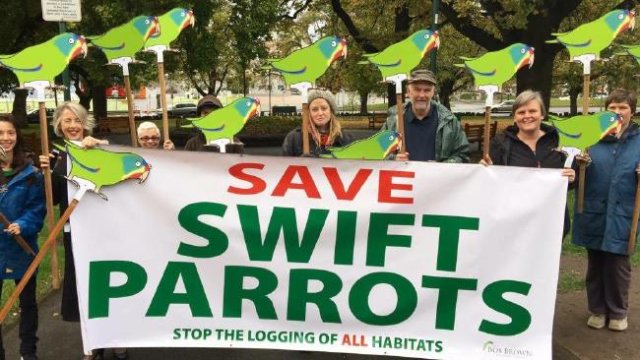
The Bob Brown Foundation launched a new website, SaveBrunyIsland.org, on May 3 with a peaceful demonstration outside Hobart's Parliament House. Conservationists held placards of the swift parrot, with an image drawn by cartoonist First Dog on the Moon.
The new campaign is designed to mobilise members of the community to urge the Prime Minister and Tasmania's Premier Will Hodgman, to protect all swift parrot habitat in secure reserves. The campaign will also target customers of logging company Ta Ann, asking them to reject timber logged in swift parrot habitat.
The Bob Brown Foundation launched a new website, SaveBrunyIsland.org, on May 3 with a peaceful demonstration outside Hobart's Parliament House. Conservationists held placards of the swift parrot, with an image drawn by cartoonist First Dog on the Moon.
The new campaign is designed to mobilise members of the community to urge the Prime Minister and Tasmania's Premier Will Hodgman, to protect all swift parrot habitat in secure reserves. The campaign will also target customers of logging company Ta Ann, asking them to reject timber logged in swift parrot habitat.
Swift parrots, the fastest parrot on Earth, are endemic to south-eastern Australia. They undertake the longest migration of any parrot species in the world. In spring they fly from the east coast of mainland Australia across Bass Strait to breed in Tasmania's eucalypt forests.
The forests they depend on for breeding in Tasmania and for winter shelter on mainland Australia are being destroyed. Swift parrots will not survive further habitat loss. A permanent ban on logging in all its forest habitat is urgent.
The aim of the campaign is to end logging on Bruny Island, 50 kilometres off the east coast of Tasmania, and add all its unprotected forests to the South Bruny National Park. Free from sugar gliders, which eat swift parrots in their nests, Bruny Island is a crucial breeding ground for these critically endangered birds.
Conservation biologists have found the presence of sugar gliders has been catastrophic for the species' survival and loss of old growth eucalypt forest dramatically raised the risk the birds and their young would be killed by sugar gliders.
Swift parrots also breed in threatened forests from St Helens in the northeast of Tasmania, down the east coast and in the southern forests.
If the Swift Parrot is to be saved from extinction, logging must stop permanently in all its breeding habitat throughout Tasmania.
Last year, 500 hectares of Bruny Island's forests were earmarked by Forestry Tasmania for logging over the next three years. Following an outcry from the island's residents and conservationists, the government suspended logging on Bruny Island.
The Bob Brown Foundation's Jenny Weber said: “Bruny Island's logging moratorium is only a temporary reprieve, not secure protection for these forests or the Swift Parrot. The forests on Bruny Island need to be added to the South Bruny National Park.
“Swift Parrot habitat remains on Forestry Tasmania's logging schedule. All logging of Swift Parrot breeding habitat should cease immediately, future logging plans for the habitat needs to be scrapped and replaced by secure long-lasting conservation reserves. The Tasmanian government must act to prevent extinction of a critically endangered species.
“If the world's fastest parrot is to survive, it is critical that logging is permanently halted on Bruny Island and in all Swift Parrot breeding habitats in Tasmania.”
Like the article? Subscribe to Green Left now! You can also like us on Facebook and follow us on Twitter.